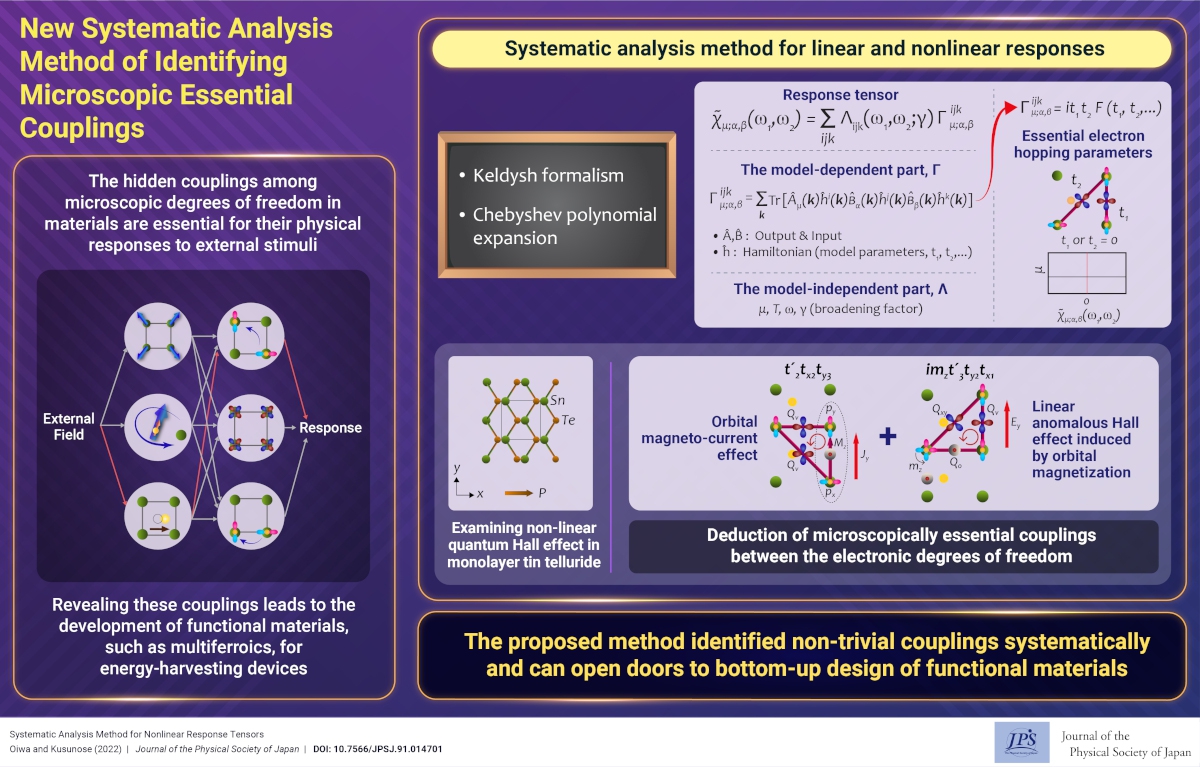New Systematic Analysis Method of Identifying Microscopic Essential Couplings
© The Physical Society of Japan
This article is on
Systematic Analysis Method for Nonlinear Response Tensors
(JPSJ Editors' Choice)
J. Phys. Soc. Jpn. 91, 014701 (2022).
We propose a systematic method of identifying essential model parameters for nonlinear response tensors. The analysis results reveal fundamental couplings in nontrivial responses and promote further development of multiferroic responses.

Discovering physical responses and elucidating their microscopic mechanisms are central subjects in condensed matter physics. Recently, various linear and nonlinear responses, such as the anomalous Hall effect under antiferromagnetic orderings and nonlinear optoelectronic transport, have been extensively investigated. These responses have been mainly analyzed theoretically by electronic-structure calculation, group-theoretical argument with electronic multipoles, and Berry curvature interpretation in the context of the topology of electronic states. These approaches have their own advantages: the electronic-structure calculation takes account of the complicated electronic band structures quantitatively, while the argument with the electronic multipoles can identify the relevant electronic degrees of freedom from the symmetry viewpoint.
However, in reality, the system contains numerous model parameters, making it difficult to determine the most important factor in various linear and nonlinear responses. Thus, identifying the essential parameters in the responses is significant to obtain a deeper understanding of multiferroic responses, and once determined, they provide a microscopic picture of the response. In other words, minimal couplings among the model parameters, such as electron hopping and spin-orbit coupling, and electric and/or magnetic order parameters are identified, and they provide a useful guideline for designing novel functional materials.
We proposed a systematic analysis method for linear and nonlinear responses that enables us to extract essential model parameters from a large number of parameters of a given theoretical model. Using the Keldysh formalism and Chebyshev polynomial expansion method, the response tensors are decomposed into model-independent and model-dependent parts; the latter is expressed as a power series of the Hamiltonian matrix and operators describing the external input and resultant response. By analyzing the low-order contributions in the model-dependent part analytically, we can identify essential parameters and deduce a microscopic picture of the response as a minimal coupling between the degrees of freedom associated with the essential parameters. We demonstrated our method by analyzing the nonlinear Hall effect in the ferroelectric SnTe monolayer and elucidated the significance of a second-neighbor diagonal hopping with an orbital exchange that always exists regardless of ferroelectric ordering.
The present method is applicable to a wide range of materials such as inorganic/organic molecules and quantum dots because it is not restricted to the periodicity of the crystal. Similarly, the present systematic analysis method reveals hidden couplings between transfer integrals, spin-orbit coupling, and order parameters in various materials, and is expected to provide a useful design guideline for future functional materials.
(Written by R. Oiwa on behalf of all authors)
Systematic Analysis Method for Nonlinear Response Tensors
(JPSJ Editors' Choice)
J. Phys. Soc. Jpn. 91, 014701 (2022).
Share this topic
Fields
Related Articles
-
Antiferromagnetism Induces Dissipationless Transverse Conductivity
Electronic transport in condensed matter
Magnetic properties in condensed matter
Electronic structure and electrical properties of surfaces and nanostructures
2024-7-24
An investigation using high-quality NbMnP crystals demonstrates that the anomalous Hall conductivity arising from antiferromagnetism is dissipationless, as expected from the intrinsic mechanism.
-
d2 Trimer and d3 Tetramer in a Pyrochlore Lattice
Dielectric, optical, and other properties in condensed matter
Electron states in condensed matter
2024-7-11
Based on the charge disproportionation of V3+ and V2+, the V3+(d2) trimers and V2+(d3) tetramers in the vanadium pyrochlore lattice of AlV2O4 are described by the orbitally-induced Peierls mechanism.
-
Structural Rotation and Falsely Chiral Antiferromagnetism: A New Combination Generating Ferrotoroidic State
Magnetic properties in condensed matter
Dielectric, optical, and other properties in condensed matter
2024-7-4
The ferrotoroidic state, an exotic state of matter with broken space inversion and time-reversal symmetries, was achieved by combining structural rotation and falsely chiral antiferromagnetism in PbMn2Ni6Te3O18.
-
Exploring Electronic States in BEDT-TTF Organic Superconductors
Superconductivity
Electronic transport in condensed matter
Magnetic properties in condensed matter
2024-4-24
This review, published in the Journal of the Physical Society of Japan, provides a comprehensive summary of the electronic states observed in BEDT-TTF type organic superconductors, including metal-insulator transitions, Mottness transitions, non-Fermi liquids, quantum spin liquids, and Bose-Einstein condensation.
-
Conversion of Chiral Phonons into Magnons in Magnets
Electronic transport in condensed matter
2024-4-1
A new phenomenon involving the conversion of chiral phonons into magnons is theoretically predicted. The effective magnetic field induced by chiral phonons causes a change in the spin magnetization of magnets.
